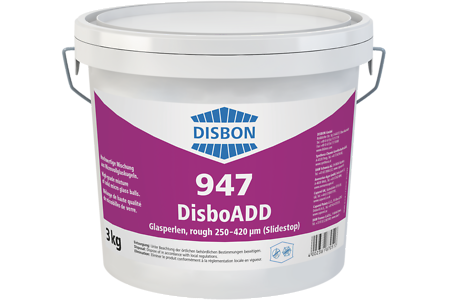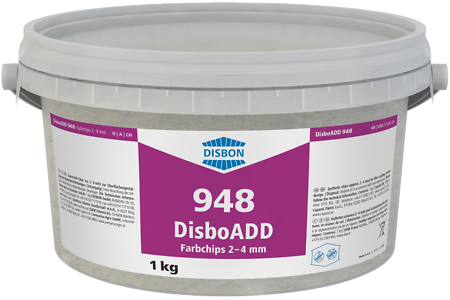Field of Application
Interior mineral floor spaces and hard asphalt screeds, exposed from low to average loads, in the private sphere or industrial and commercial sectors.Floor spaces in garages, cycle-stands, wash and sanitary rooms.
Due to the emission-minimised and TÜV monitored formula particularly suitable for all sensitive areas, as e.g. lounges, hospital facilities, nursery schools and day-care facilities for children, schools, etc.
Material Properties
- High impact strength
- Excellent cleanability
- Very good abrasion resistance
- Little abrasive wear
- Allows water vapour diffusion
- Good chemical resistance
- Tire resistant - Resistant to the penetration of plasticizers/softening agents
- Ecologically compatible, because water-thinnable (dilutable)
- Emission-minimised, tested for harmful substances and monitored by Technical Control Board (TÜV)
| Tested & approved according to AgBB testing criteria for VOC emissions from building material that is used for interior work. The criteria of AgBB (Ausschuss zur gesundheitlichen Bewertung von Bauprodukten; Commission for the sanitary evaluation of building material) are elaborated by the ecological and sanitary authorities for the use of building material in „delicate/sensitive" areas, as e.g. lounges. |
Material Base / Vehicle
Water-thinnable, 2-component epoxy resin
Packaging/Package Size
- Standard
5 kg, 10 kg plastic combi-packaging - ColorExpress
5 kg, 10 kg plastic combi-packaging
Colours
- Standard:
10 kg container: Kieselgrau (Gravel Grey), Betongrau (Concrete Grey), Mittelgrau (Medium Grey).
5 kg container: Kieselgrau (Gravel Grey), Betongrau (Concrete Grey).
Special colours available on request.
- ColorExpress:
Over 25,000 shades are available in the ColorExpress stations. Exclusive colouring is possible due to colour shades of the FloorColor plus collection.Depending on the shade, base 1, base 2 or base 3 can be mixed via ColorExpress stations.
Slight discolouration and chalking effects may occur with weathering and UV light exposure. The colourants in e.g. coffee, red wine or leaves (organic dyestuffs) and various chemicals, e.g. disinfectants, acids, etc., may cause discolouration. Scratch marks may appear on the surface due to continued rubbing/sliding. Proper functioning of the coating will not be affected by these changes.
Gloss Level
Glossy
Storage
Keep in a cool, dry and frost-free place. Shelf life of the original, tightly closed packaging: Minimum2 years. If temperatures are low, the material should be stored at 20 °C before application.
Density
Approx. 1.4 g/cm³Dry film thickness
Approx. 35 µm/100 g/m2Resistance-count for diffusion µ (H2O)
Approx. 20,000Abrasion to Taber (CS 10/1000 U/1000 g)
66 mg/30 cm2Chemical resistance
Chemical Resistance Table according to DIN EN ISO 2812 at 20 °C| 7 days | |
| Acetic acid, 5 % solution | + (D) |
| Sulphuric acid, 20 % solution | + (D) |
| Nitric acid, 10 % solution | + (D) |
| Hydrochloric acid, 10 % solution | + (D) |
| Liquid ammonia, 25 % solution | + |
| Xylene (Xylol) | + |
| Test fluid group 5✱ | + |
| De-icer | + |
| Petrol / gasoline DIN 51 600 | + |
| Test fluid group 4✱ | + |
| Skydrol (hydraulic fluid) | + |
| Shell Diala-oil (transformer coolant) | + |
| Legend:+ = Resistant, (D) = Discolouration✱ Acc. to German construction and test guidelines for water protection (DIBt). | |
Suitable Substrates
All interior mineral substrates (e.g. concrete, cement-based, anhydride and magnesite screed) and hard asphalt screed. The substrate must be sound, dimensionally stable, solid, free from all materials that may prevent good adhesion, e.g. loose/brittle materials, dust, oils, fats/greases or abraded rubber contamination (scuff/skid marks). Cementitious flow mortars, ameliorated with synthetic resin, must be checked for compatibility by trial application, if necessary. The adhesive tensile (pull-off) strength of substrates must be 1.5 N/mm2. Substrates must have achieved their equilibrium humidity:
Concrete and cement-based composition floor (screed): max. 5% by weight
Anhydrite screed: max. 1 % by weight
Magnesite screed: 2 – 4 % by weight
Xylolithe (Magnesium Oxychloride) screed: 4 – 8 % by weight
Hard asphalt screeds must correspond to hardness class IC 15 and should not warp on the given temperature and mechanical load conditions.
Substrate Preparation
Prepare the substrate by suitable means, e.g. grit blasting (shot peening) or milling, in order to fulfil the above mentioned requirements.
Unsound, highly soiled surfaces (e.g. with oils, fats/greases, rubber abrasion), chalking or vitreous cement laitance surfaces must be prepared intensively by mechanical means with shot/grit blasting or similar equipment. Small surfaces may be treated manually with special tools like cleaning-rod, needle pistol, etc. Especially the tracks on used garage floors are to be treated very thoroughly. Oil stains must be removed with suitable degreasing agent.
Hard asphalt screeds: After having completed with preparation the aggregate should be visible for at least 75%.
One-component and loose, unsound two-component coatings must always be removed.
Vitreous surfaces and existing sound, rigid two-component coatings must be cleaned and slightly roughened or flattened with blasting device or should be primed with Disbon 481 EP-Uniprimer.
Fill spallings and defects on the substrate flush with the surface using Disbocret® PCC Mortars or Disboxid EP Mortars.
Preparation of Material
Stir the base material, then add the hardener and stir intensively with a low-speed electric paint agitator (max. 400 rpm), until a homogenous, streak-free colour shade is achieved. Pour the mixture into another container and continue stirring.Mixing Ratio
Base material (component A) : hardener (component B) = 84 : 16 parts by weight
Method of Application
The material is applicable by paint brush, roller or spraying equipment (airless, without filter, min. 50 bar, nozzle 0.015 – 0.017 inch, spray angle 45°, subsequently to be treated with a roller).
Surface Coating System
Priming Coat
New, slightly absorbent mineral substrates and hard asphalt screeds may be primed with Disbopox 442 GaragenSiegel, diluted 5 -10 % with tap (potable) water.
Optimum adhesion on mineral substrates is achievable with a priming coat of Disbopox 443EP Impregnation. The priming coat should always be intensively applied by sealer brush.
Even, semi-rough mineral substrates:
Prepare a mixture of
Disbopox 442 GaragenSiegel: 1 part by weight
Disboxid 942 Mischquartz (quartz sand): 1 part by weight
Pour the scratch filler compound onto the primed surface, spread evenly using smoothing trowel, then draw off all excessive material to achieve a layer thickness in particle size of the aggregate:Max. 2 mm.
Strew/cover the completed surface with a surplus of quartz sand Disboxid 942.
| Please Note: Burrs and a higher surface unevenness may be noticeable, even after having treated/covered with quartz sand. The surface should be grinded, if necessary. |
Coating
Apply intermediate and finishing coats always undiluted. Dilute the material for intermediate coat with 5 % of tap water, when the surface has been strewn with quartz sand. An extreme colour contrast or highly intensive colours, e.g. tinted via ColorExpress base 3, may require the application of a 3rd coat, provided that a high-quality visual appearance is desired.
Surface Design/Treatment with Color-Chips
Strew Disboxid 948 Color-Chips into the freshly applied coating and seal the dried surface with Disbopur 458 PU-AquaSiegel for smooth aspect or add 3 % by weight of Disbon 947 SlideStop Fine for anti-slip effect.
Consumption
| Priming Coat | |
| Mineral substrates Disbopox 442 GaragenSiegel orepoxy impregnation Disbopox 443 | Approx. 200 g/m2 |
| Hard asphalt screeds Disbopox 442 GaragenSiegel | Approx. 200 g/m2 |
| Scratch Filler Application for even, semi-rough substrates: | |
| Disbopox 442 GaragenSiegel Disboxid 942 | Approx. 1.1 kg/m2/mm Approx. 1.1 kg/m2/mm |
| Sand to be strewn Disboxid 942 GaragenSiegel | Approx. 1.5–2 kg/m2 |
| Coating | Approx. 230–250 g/m2 per coat |
| Surface Treatment (Design) | |
| Chips to be strewn Disboxid 948 Color-Chips | Approx. 30 g/m2 |
| Even sealing Disbopur 458PU-Aquasiegel | Approx. 130 g/m2 |
| Sealing withanti-slip effect Disbopur 458 PU-AquaSiegel Disbon 947 SlideStop Fine | Approx. 130 g/m2 Approx. 4 g/m2 |
Workability
At 20 °C and 60% relative humidity approx. 90 minutes. Higher temperatures shorten and lower temperatures extend the pot life.| Note: Avoid the application of excessively thick layers for each coat (additional consumption). Ventilate well during drying and hardening phase. |
Application Conditions
Material, Atmospheric, and Substrate Temperature
must remain at a min. of 10 °C and max. 30 °C during application and drying. Relative humidity must not exceed 80 %. Substrate temperature should always be min. 3 °C above the dew point temperature.
Waiting Time
The waiting time between work steps is minimum 16 hrs and max. 48 hours at 20 °C. If waiting times are longer, the surface of the preceding coat must be roughened (sanded). Higher temperatures shorten and lower temperatures extend the given time period.Drying/Drying Time
At 20 °C and 60 % relative humidity walkable after approx. 1 day. Ready for mechanical loads after approx. 3 days. Completely hardened after approx. 7 days.Lower temperatures extend the drying time. During the drying process (approx. 24 hours at 20 °C), the coat should be protected against moisture/humidity to avoid surface failures and loss of adhesion.
Tool Cleaning
Immediately after use or during longer breaks with water or warm soapy water.
German Certificates
- 1-1042: Testing of decontaminability according to DIN 25415, T1
Nuclear Research Centre Karlsruhe - 1-1279: Testing the anti-slip properties of floorings R12
Material Testing Institute Hellberg, Adendorf - 1-1238: Testing the anti-slip properties of floorings R11
Material Testing Institute Hellberg, Adendorf - 1-1242: General Technical Approval for the use within habitable rooms
Z-156.605-639, German Institute for Structural Engineering, Berlin - 1-1213 Certificate tested related to harmful substances (standard colour), TÜV Nord
- 1-1214 Certificate tested related to harmful substances (mixed colours), TÜV Nord
Special Risks (Hazard Note) / Safety Advice (Status as at Date of Publication)
For professional use only.
Base material:Risk of serious damage to eyes. Keep container tightly closed and in a well-ventilated place. Do not breathe vapours, aerosols. Avoid contact with skin. In case of contact with eyes, rinse immediately with plenty of water and seek medical advice. After contact with skin, wash immediately with plenty of soap and water. Do not empty into drains, dispose of this material and its container at hazardous or special waste collection point. Wear suitable protective clothing, gloves and eye/face protection.
Hardener: Irritating to eyes and skin. May cause sensitization by skin contact. Toxic to aquatic organisms, may cause long-term adverse effects in the aquatic environment. Keep container tightly closed and in a well-ventilated place. Do not breathe spray, vapour. Avoid contact with skin. In case of contact with eyes, rinse immediately with plenty of water and seek medical advice. After contact with skin, wash immediately with plenty of soap and water. Do not empty into drains, dispose of this material and its container at hazardous or special waste collection point. Wear suitable protective clothing, gloves and eye/face protection. Contains epoxy-based compounds. See information supplied by the manufacturer (Material Safety Data Sheet/MSDS).
Disposal
Materials and all related packaging must be disposed of in a safe way in accordance with the full requirements of the local authorities. Particular attention should be made to removing wastage from site in compliance with standard construction site procedures.In Germany: Only completely emptied containers should be given for recycling. Residues: Allow base material and hardener to cure and dispose of as paints waste.
EU limit value for the VOC content
of this product (category A/j): max. 140 g/l (2010).This product contains max. 100 g/l VOC.Giscode
- Standard and special colours: RE 1
- ColorExpress colours: RE 2
Further Details
See Material Safety Data Sheets (MSDS).Follow the application references and advice for the upkeep of floorages while applying our materials.
CE Labelling
EN 13813CE labelling is based on EN 13813 "Screed mortars, screed compounds and screeds – screed mortars and screed compounds – Properties and Requirements" defining the requirements for screed mortars being used for floor constructions in the interiors. The standard also include synthetic resin coatings and sealing.
Products which match the above mentioned standard are to be labelled with the CE mark.
Customer Service Centre
Tel.: +49 6154 71-71710Fax: +49 6154 71-71711
e-mail: kundenservicecenter@caparol.de
International Distribution: Please see www.caparol.com










